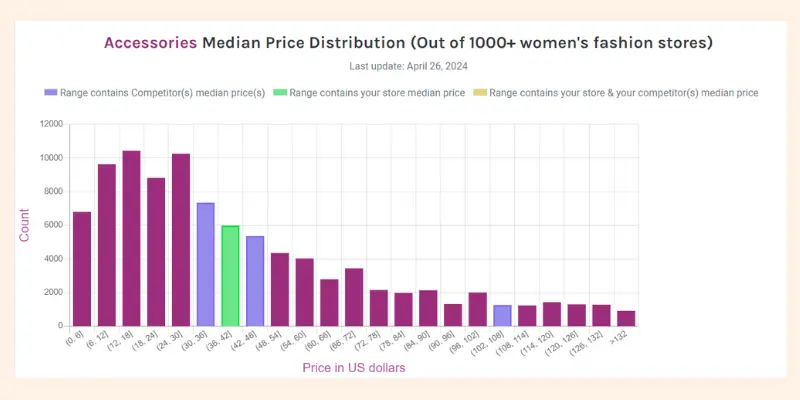Dominate the fashion scene with powerful market research & competitive analysis strategies. Learn how to understand your customers, analyze competitors, and translate data into actionable plans for success.
In the ever-evolving world of fashion, staying ahead of the curve isn’t just a suggestion; it’s a survival tactic. As a fashion consultant, marketer, or e-commerce brand owner, navigating this dynamic landscape requires a keen understanding of your audience and a clear picture of the competitive terrain.
This is where market research and competitive analysis come into play, acting as your essential tools for informed decision-making.

Why Market Research & Competitive Analysis Matter for Fashion Businesses?
Imagine designing a breathtaking collection, only to find it sitting on the shelves because it misses the mark with your target audience. Or, launching a marketing campaign that gets drowned out by your competitor’s more effective strategies.
Market research and competitive analysis help you avoid these pitfalls by providing invaluable insights into:
- Customer Needs & Preferences: What styles, trends, and price points resonate with your ideal customer base?
- Market Gaps & Opportunities: Are there unmet needs or emerging trends your brand can capitalize on?
- Competitive Landscape: Who are your direct and indirect competitors? What are their strengths and weaknesses?
- Marketing Effectiveness: How are your competitors attracting and engaging customers? What’s working and what’s not?
Market Research for Fashion Businesses: Unveiling the Customer Journey
Market research delves into the hearts and minds of your target audience, helping you understand their buying habits, motivations, and preferences. Here are some of the key market research methods to consider:
- Surveys & Questionnaires: Gather direct feedback from potential and existing customers about their fashion preferences, shopping habits, and brand perceptions. Utilize online surveys, in-store questionnaires, or focus groups to get a well-rounded perspective.
- Social Listening & Reviews: Today’s fashion-savvy consumers are vocal online. Leverage social media listening tools to identify conversations surrounding fashion trends, brands, and customer sentiment. Analyze online reviews to understand customer pain points and areas for improvement.
- Website Analytics: Analyze your website traffic data to understand which styles and products garner the most interest. Tools like Google Analytics reveal where your customers are coming from, what products they browse, and where they drop off in the buying journey.
- Industry Reports & Trends: Stay informed about current trends and consumer behavior by reading industry reports from Fashion Snoops, WGSN, and Euromonitor International.
Competitive Analysis: Your Fashion Intelligence Mission
Once you understand your target audience, it’s time to analyze the competition. Consider these methods:
- Identify Your Competitors: Define your direct competitors (brands targeting the same audience with similar products) and indirect competitors (brands offering different products but competing for the same customer’s budget). Analyze major online retailers and fast fashion brands relevant to your niche. Try www.plumfind.com to track your competitors.
- Website & Social Media Analysis: Scan your competitors’ websites and social media presence. Analyze their product offerings, marketing strategies, brand messaging, and customer engagement tactics. You can do this analysis for free in a few clicks at www.plumfind.com.
- Pricing & Promotional Strategies: Compare your pricing structure and promotional offers to those of your competitors. With Plumfind, you can also compare your prices with those of your competitors.
- Customer Reviews & Brand Perception: What are customers saying about your competitors online? Analyze online reviews and social media conversations to identify their strengths and weaknesses in customer service, product quality, and brand experience.
Fashionable Insights: Transforming Data into Actionable Strategies
By combining market research and competitive analysis, you gain a comprehensive understanding of your market position. Here are ways to translate this knowledge into actionable strategies:
- Product Development: Refine your collections based on customer preferences and market gaps identified through research.
- Marketing & Sales Strategies: Develop targeted marketing campaigns that resonate with your audience and stand out from the competition. Consider influencer marketing, social media campaigns, or personalized email marketing strategies.
- Pricing & Promotions: Refine your pricing strategy to be competitive yet profitable. Offer compelling promotions without resorting to deep discounts that erode brand value.
- Customer Experience: Enhance the customer journey by addressing pain points identified in reviews and improving customer service based on competitor best practices.

A Fashionable Advantage: Continuous Learning & Monitoring
Market research and competitive analysis are ongoing processes. As trends evolve and competitors shift strategies, regular monitoring is crucial. Here are tips to stay ahead of the curve:
- Set Up Alerts: Implement tools like Plumfind that send alerts when competitors update their pricing, launch new campaigns, or receive online mentions.
- Subscribe to Industry Publications: Stay informed about industry trends, forecasts, and competitor moves through reputable fashion publications and newsletters.
- Schedule Regular Reviews: Set aside time to review market research and competitive analysis data quarterly or bi-annually. This allows for course correction and strategic adjustments based on the evolving landscape.
While surveys, social listening, and website analytics form the core of market research, consider these advanced methods for a richer understanding:
- Customer Segmentation: Divide your target audience into distinct groups based on demographics, psychographics, and buying behaviors. This allows for targeted messaging and product development tailored to each segment. Tools like customer relationship management (CRM) platforms or data analytics software can help identify customer segments within your existing customer base.
Example: A contemporary womenswear brand might segment its target audience into “career women,” “eco-conscious shoppers,” and “trendsetters,” each requiring different product features and marketing approaches. - A/B Testing: Test different versions of website elements, email marketing campaigns, or product features to see which ones resonate best with your audience. A/B testing allows for data-driven optimization of your marketing efforts.
Example: You might test two different product descriptions for a new dress on your website’s landing page. Analyzing website conversion rates helps determine which description leads to more purchases. - Focus Groups & In-Depth Interviews: While surveys offer broad insights, focus groups and in-depth interviews allow for nuanced exploration of customer perceptions and decision-making processes. These methods delve into the “why” behind customer behavior.
Example: Conduct a focus group with young millennials interested in athleisure wear to understand what styles, price points, and brand values influence their purchasing decisions.

Building a Culture of Data-Driven Decision Making
Fashion is an art form, but success in the industry requires a balance of creativity and data-driven insights.
Invest in Data Analytics Tools that aggregate your website traffic data, social media analytics, and customer feedback. These tools provide valuable dashboards and reports to inform strategic decisions.
You should ensure that key decision-makers in your company understand the importance of market research and competitive analysis data. Encourage them to participate in interpreting data and translating it into actionable strategies.
www.plumfind.com for example, can help you analyze your competitors’ websites within minutes.
Market research and competitive analysis are not one-time tasks but an ongoing process. By consistently gathering insights, analyzing data, and refining strategies, fashion businesses can navigate the ever-evolving landscape.
Remember, the most successful brands learn to master the mirror – understanding not just their own strengths and weaknesses, but also those of their competitors. Through a commitment to data-driven decision making and ethical practices, fashion brands can achieve sustainable success and contribute to a thriving fashion ecosystem.
About the author(s):
Natasha is our Social Media Manager, a law student, and marketing enthusiast. She loves strategizing different methods to get results. A big fan of startups and their psychological aspects. She loves to travel and interact with locals to know the history of those places. She lives in Jaipur, India.

Leave a Reply